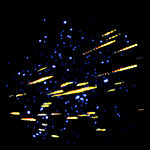象限仪座流星雨
| 象限仪座流星雨 Quadrantids (QUA) | |
|---|---|
| 发现日期 | 1820s[1] |
| 母体 | (196256) 2003 EH1 |
| 辐射点 | |
| 星座 | 牧夫座 |
| 赤经 | 15h 28m[1] |
| 赤纬 | +50°[1] |
| 性质 | |
| 出现时期 | 前一年12月28日至隔年1月12日[1] |
| 峰值日期 | 1月3日[1] |
| 速度 | 41[2] km/s |
| 每小时天顶流星数 | 120 [3] |

象限仪座流星雨(QUA)是一月的流星雨。这场流星雨的天顶每小时流星率(ZHR)可以像8月的英仙座流星雨和12月的双子座流星雨一样高[4],达到120。但是,持续的时间较短,通常只有数小时。此外,流星的视星等较为黯淡,多数仅在3〜6等之间。
虽然这个流星雨的辐射点位于牧夫座的区域内,但名称却来自一个现已经废弃的星座——象限仪座,它有一部分所属于现在的牧夫座。
象限仪座流星雨的原名
[编辑]在国际天文联会未统一流星雨命名准则前,流星雨会因不同的原因,用彗星 (例如:贾可比尼流星雨)、传统名称 (例如:国际天文联会未统一星座名称前,曾经存在过的象限仪星座) 或者现时通用的名称来称呼,因此有机会出现同一个流星雨可能有不同名称的现象。后来国际天文联会决定采用流星雨辐射点位置所在星座为流星雨命名 [5], 将象限仪座流星雨正名为“天龙座流星雨”,但是这个辐射点现时已经转移到牧夫座(国际流星组织在它早期出版的《目视流星观测手册》中,亦曾经按照上述定义,称这个流星雨做“牧夫座流星雨”)。因此在决议案后出版的中文天文书刊,大部分跟随国际天文联会议决,采用流星雨辐射点位置所在的天龙星座去翻译成为“天龙座流星雨”或者“一月天龙座流星雨”[6][7]。
采用废弃星座命名的原因
[编辑]虽然国际天文联会用“天龙座流星雨”为正式名称一段时间,但是一般流星观测者和部分传媒,很多仍然采用“象限仪座流星雨”作为惯用名称。为免混乱,国际天文联会2009年8月7日在巴西里约热内卢的大会中[8],投票通过64个流星雨的正式名称, 其中包括采用在1922年5月议决废弃的象限仪星座,作为一月“天龙座流星雨”的替代名称[9]。自此之后,才再次统一称为“象限仪座流星雨”
不能称为“象限仪流星雨”
[编辑]国际天文联会对于流星雨/流星群的官方正式名字有严格的规定,因为他们是用星座的属有格来区分各种不同的流星雨/流星群的情况[10]。
对于采用星座名称命名的流星雨,流星雨中的“座”字是不能省略,如果省略了就会和没有星座名称的流星雨名词,例如:“白天流星雨”混淆。因此必须按照官方命名翻译为“象限仪座流星雨”不能称为“象限仪流星雨”。
流星雨的母体
[编辑]前美国太空总署流星雨专家彼得·詹尼斯肯斯(Peter Jenniskens)在2003年12月发现这个流星雨是地球经过第196256号小行星(临时编号 2003 EH1)(参考paper by Peter Jenniskens(页面存档备份,存于互联网档案馆))在轨道上的残留物所形成的。196256号小行星是一颗编号C/1490 Y1 [11]解体彗星的彗核。彗星在530年前分裂成为碎块,当时中国、日本和韩国天文学家都有观测的纪录。剩下的彗核就是惰性的岩石或是类似于砾石性质的一颗小行星。
观测
[编辑]由于196256号小行星和它的母体彗星碎片运行轨道与地球轨道差不多成垂直位置,所以象限仪座流星雨的特色是高峰期短,只有不足半天的时间。
观测象限仪座流星雨的最佳时刻是每年的1月4日,而在每年的年底12月28日至1月12日都会有少量属于这群的流星出现。
在2008年1月4日的一次最佳观测时间,当时最佳的地点则在美国东部和西欧[12] [13] [14] 。美国太空总署使用一架湾流V型飞机研究这次的流星雨[15]。
流星雨时间系列
[编辑]| 年份 | 流星雨有效运行期间 | 流星雨高峰 | ZHRmax |
|---|---|---|---|
| 2008 | 1月1日–5日 | 1月4日 | 82[16] |
| 2009 | 1月1日–5日 | 1月3日 | 146[17] |
| 2010 | 渐盈月[18] (12月13日满月)[19] | ||
| 2011 | 12月28日 – 1月12日 | 1月3日 | 90[20] |
| 2012 | 12月28日 – 1月12日 | 1月4日 | 83[21] |
| 2013 | 1月3日渐盈月(12月28日满月)[22] | 137[23][24] | |
| 2014 | 在世界时1月3日17时和22时30分期间迎来极盛,ZHR最大值为245颗, 1月4日18时出现孤立飙升,ZHR最大值为315颗。 | 315[25] | |
| 2016 | 1月3日 14 UT [26] (15 CET/9 EST) | ||
| 2017 | 1月3日 15 UT [27] (16 CET/10 EST) | ||
| 2018 | 1月3日 19 UT [28] (20 CET/14 EST) | ||
| 2019 | 1月4日 2 UT [29] (21 EST on Jan. 3) | ||
| 2020 | 1月4日 4 UT [30] (23 EST on Jan. 3) | ||
| 2021 | 1月3日 |
参考资料
[编辑]- ^ 1.0 1.1 1.2 1.3 1.4 Moore, Patrick; Rees, Robin, Patrick Moore's Data Book of Astronomy 2nd, Cambridge University Press: 275, 2011 [2020-01-16], ISBN 0521899354, (原始内容存档于2020-04-24).
- ^ Millman, Peter M.; McKinley, D. W. R., The Quadrantid Meteor Shower, Journal of the Royal Astronomical Society of Canada, December 1953, 47: 237, Bibcode:1953JRASC..47..237M.
- ^ Peter Jenniskens. 2003 EH1 is the Quadrantid shower parent comet. The Ephemeris (San Jose Astronomical Association newsletter). Dec 8, 2003 [2004-12-17]. (原始内容存档于2005-02-19).
- ^ Does the published meteor rate for a shower really represent what I should expect to see?. American Meteor Society. [2012-12-29]. (原始内容存档于2020-05-14).
- ^ IMO Visual Meteor Observation Manual
- ^ 香港天文學會討論區《掩星組文件》流星雨中文譯名準則. [2018-10-09]. (原始内容存档于2018-10-10).
- ^ 香港天文学会《会讯》(第四十四届第二期),第8至13页
- ^ IAU General Assembly 2009 Newspaper
- ^ 国际天文学连合、64の流星群の公式名称を决定
- ^ Transections IAU, Volume XXVIIB Proc. XXVII IAU General assembly, August 2009
- ^ 2003 EH1 Is the Quadrantid Shower Parent Comet. [2008-01-07]. (原始内容存档于2008-01-05).
- ^ Joe Rao, Skywatching Columnist. Must-See Meteor Shower Friday Morning. January 3, 2008 [2008-01-03]. (原始内容存档于2008-07-09).
- ^ "Scientists Fly to 2008's Most Dazzling Meteor Shower". Slashdot.org. [2008-01-02].
- ^ Quadrantid Meteor Shower Will Sparkle on January 3rd. Universe Today. December 28, 2007 [2008-01-02]. (原始内容存档于2008-01-01).
- ^ "International Space Updates: 2008"; NASA again postpones the launch of Atlantis; Gulfstream V will be used to study meteor shower; Russia will have to find new places to lodge its space tourists. Daily Tech. January 1, 2008 [2008-01-02]. (原始内容存档于2016-03-04).
- ^ Quadrantids 2008: visual data quicklook. [2020-01-16]. (原始内容存档于2013-02-02).
- ^ Quadrantids 2009: visual data quicklook. [2020-01-16]. (原始内容存档于2013-02-02).
- ^ IMO Meteor Shower Calendar 2010: January to March. [2020-01-16]. (原始内容存档于2016-10-16).
- ^ U.S. Naval Observatory Phases of the Moon 2009. [2020-01-16]. (原始内容存档于2016-03-03).
- ^ Quadrantids 2011: visual data quicklook. [2011-01-09]. (原始内容存档于2016-03-25).
- ^ Quadrantids 2012: visual data quicklook. [2020-01-16]. (原始内容存档于2012-12-25).
- ^ U.S. Naval Observatory Phases of the Moon 2012. [2020-01-16]. (原始内容存档于2012-04-14).
- ^ Quadrantids 2013: visual data quicklook. [2020-01-16]. (原始内容存档于2013-12-24).
- ^ 2013 Quadrantid Shower (页面存档备份,存于互联网档案馆) (Chris L Peterson @ Cloudbait Observatory)
- ^ Quadrantids 2014: visual data quicklook. [2020-01-16]. (原始内容存档于2015-11-17).
- ^ IMO Meteor Shower Calendar (PDF). International Meteor Organization. (原始内容存档 (PDF)于2019-12-04).
- ^ Quadrantid meteors on January 3 or 4. (原始内容存档于2019-12-04).
- ^ When and Where to See the Quadrantids in 2018. (原始内容存档于2020-04-27).
- ^ McClure, Bruce. Dark Skies for 2019 Quadrantid meteors. Earthsky. [2018-11-16]. (原始内容存档于2018-11-17).
- ^ QUADRANTIDS METEOR SHOWER 2020. Bashewa. Bronberg Weather Station. [2019-12-30]. (原始内容存档于2020-04-28).
外部链接
[编辑]- Quadrantids Create Year's First Meteor Shower(页面存档备份,存于互联网档案馆) (NASA 01.02.12)
- International Meteor Organization 2010 Meteor Shower Calendar (页面存档备份,存于互联网档案馆)
- NASA Quadrantid Airborne Campaign(页面存档备份,存于互联网档案馆)
- Meteorblog.com(页面存档备份,存于互联网档案馆)
| ||||||||||||||||||||||||||||||||||||||||||||||||||||||||||||||||||||||||||||||||||||||||
Text is available under the CC BY-SA 4.0 license; additional terms may apply.
Images, videos and audio are available under their respective licenses.

